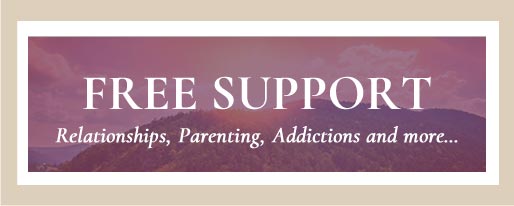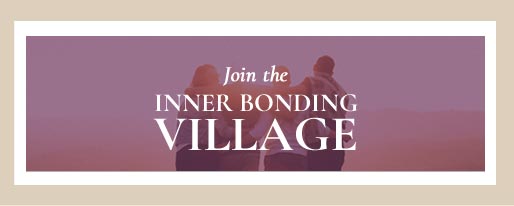Openness and Resistance: Odds and Ends
By Sharon PearsonAugust 31, 2013
It works if we work it! Inner Bonding (and 12 Steps and more)! So, why do we not work it? Why not devote our selves to Lovingness with our self and others??? Such a worthwhile goal, such wonderful experiences of healing and growth, and such a wise investment in our lives and the world! Why do we get stuck and fail to follow through? All of us learn early in Inner Bonding that we must set our intent to learn or we get nowhere in this work. We must open our hearts and will to learn to love. And yet, sometimes, we all resist! Sometimes we get stuck in resistance.
It is not possible to move beyond our resistance -- unless and until we understand and work at the level of our good reasons for resistance. I do not mean that we indulge our resistance…but being authoritarian with it does not work either, at least not for the long haul. I invite you to remember your early years in school. Were you eager to learn? Did you experience support and caring? Did you delight in your growth and new skills?
In the structures of education, many of which have created an environment dedicated to control, children respond in various ways-- compliance, avoidance, and resistance to control are common responses to the intent to “control.” What is happening in your inner schoolroom?
Young children live in a natural inclination to learn. Children are born with an inherent ability to learn from their relationships, environments, and experiences. They learn by observation and imitation, experimentation and repetition of that which captures their attention. The qualities of curiosity, wonder, and inner desire for mastery are innate and only need opportunity and support to flourish; that is easy to observe in a child’s first 3 years of life. A parent’s inordinate concern for teaching content or memorizing data in those early years (it is possible for the baby) can not only interfere with natural learning of language, social cues, gross and fine motor skills, and scientific awareness (such as the laws of physics, e.g. gravity—ouch!), but can create a predictable and natural resistance to what the child may experience as outside interference and "control." “A child's play is their work” (book by that title) and much learning is always occurring, learning that usually is superior to an "academic" and teacher-directed paradigm.
Since young children have a deep desire to please adults, they may learn to perform for adult attention and approval and can easily become "praise dependent" (external reward), rather than experiencing the inner joy of "mastery" and sense of personal competency (internal reward). Once this paradigm is in place, it is difficult to help the child return to their native and compelling motivations to learn.
When children resist learning, there are always Good Reasons. If the model of education employed is industrial/production model, chances are that so-called learning processes are oriented to management and efficiency rather than to the student. They are about quotas and outcomes and strategies and control of participants. I think of these as cookie -cutter, mass production models.
Another model is to allow children to be in the contexts of caring and competent adults who model effective life skills, relationships and self-responsibility; in such spaces growth, maturity, and healing are supported. In most situations where there are many more children than adults, and adults are assigned the responsibility of passing along particular information and skills, adults become stressed and ineffective in their leadership. Children are not adequately supported and supervised learning does take place but it is hampered – often, hurtful things are learned. If the goal is to socialize and equip children for life, that best occurs with and in a context of wise and loving and powerful adults—not in large peer groups (think Junior high school and the trauma so many children experience in those years with poor socio-emotional supports and positive modeling). We already know that when children's interests and concerns, learning styles and natural strengths are considered, learning is inspired and more effective. Loving and understanding personal adult support even goes beyond that wisdom!
Adverse Childhood Experiences (ACE factors – See Creating a Healing Society) affect “teach-ability” or openness and readiness to learn in children (and adults). Trauma, crisis, and chronic stress environments can create a "shut-down" effect. The child is focused on survival and is in a hyper-vigilant state that physiologically interferes with learning of content in an academic setting. Add poor diet, sleep deprivation, and lack of emotional support to this context and the child is literally set up for failure. Also, if the primary social context of a child (home) does not share the values and goals of the academic context, the child has little chance of "success" in their secondary environment. While children are resilient, lack of attention to their primal needs can create in them withdrawal and resistance to what they are experiencing as an external and seemingly irrelevant agenda. They may simply register “danger” and another context in which they will “fail.”
When an educator speaks of the quality of “teach-ability,” they are typically referring to openness, willingness, eagerness, interest, curiosity, self-discipline, and the intent to learn. The teacher may then focus on whether a student is competent in such ways. However, a common substitute for such qualities is "submission." That substitute is accepted, or even demanded in unsupportive or controlling environments. When a teacher settles for submission from a child, he or she undermines the larger goals of education (helping a child to develop the capacities to think carefully and to take responsibility for their life-long learning versus indoctrination). Such a teacher can also unwittingly set up patterns that encourage the child up to live in abusive contexts in their future! “Teach ability” could then be defined as a teacher’s ability to support a child in learning to take responsibility for their own learning and personal competencies, which, after all is inherent.
Teachers often identify children who are not being submissive as “un-teachable” or intractable. A more effective perception for a teacher to hold than that a child is being "un-teachable" is to look at what has been and is presently interfering with their natural orientation to learning. Rather than focusing on control, the teacher might shift to curiosity – What are the obstacles that are getting in the way of growth? For example, requiring an active and kinesthetic learner under the age of seven to sit in a chair at a desk for long stretches of time will create resistance! That approach goes against the divine design built into that child. (The American cultural dictum--"earlier is better" often gets in the way of optimal learning.) One has only to remember Einstein to recognize that the incapacity to live in and respond to a restrictive academic program is not an indicator of poor intelligence or lack of teach-ability.
There are times when resistance in a child may actually be a sign of developing competency. Children who have lived in environments that are focused on controlling participants, whether at home or at school, become resistant in their natural process of maturation and individuation. Resistance may be basic to their developing a sense of self in such a context. While such a “survival strategy” fails in development of a true identity (resistance to control is still in the control paradigm) it may be the only recourse for a child who has lived with an overwhelming sense of being invaded, engulfed, or smothered or trampled.
A similar hindrance to learning is a Co-dependent/Dependent Model that gives inappropriate support to a "learner." Support that interferes with the development of the child’s personal sense of competency is counter-productive. Interfering with natural consequences or results of a personal choice is to undermine learning about reality. For example, when a teacher insists upon too much involvement from a parent in their child's schoolwork (boundary confusion) they may actually be hampering the child. If a teacher rewards a project that is based upon adult performance, what has the child learned? What has the child internalized about their capacity to perform? The old dictum applies -- one should not do for another (as a pattern) what they can and should be doing for them selves. Appropriate expectations and goals that reflect the best understandings of human development are required. The “pain” of natural consequences, especially after the age of twelve, becomes the best teacher. Reality requires that we learn "who is responsible for what?" Clear boundaries regarding the self in relation to others are basic to socio-emotional intelligence. Again, “teach-ability” is the ability to take responsibility for learning and for personal competency. That definition can help to define the goals of any “educational enterprise.”
What is learning? What is teaching? Who is not "teachable"? It is possible for a trainer to teach an elephant to do amazing tricks. That does not make the elephant a better elephant. It just makes the animal more compatible to the trainer's needs. The bigger question is this: What is the Goal? If it is learning, then the learning should have something to do with the improvement of the one doing the learning. So, when working with a child, is the problem that they are “un-teach-able” or seemingly not cooperating with "the program"? Or, could the problem be with the party who has an agenda for the child that is not respectful of the inherent creation design inside the child? Could that party have goals that run counter to reality? So, the problem could be the one who neglects appropriate resource and support. It might even be in those who fail to address the larger social contexts that hinder development. Perhaps there are even those who are devoted to a model that is faulty, that creates problems in learning. Maybe the problem is the "teacher" who is not teachable him self or her self?
Maybe you have felt irritated or agitated and concerned about a young child screaming in a store or a restaurant late at night? Is the child the problem? Or is the problem a parent who has failed to consider the needs of the child? Was the child fed too late? Was the child given coke and sugar as pacification? Has the child been restrained too long for physical health and comfort?
Maybe the problem is bigger. Does our society adequately address the neglect or abuse of children? Even in the example above, where inadequate parenting of young children is the question (intentional or not), where is the wisdom and support of others? (We are a society that will not allow a fourteen year old to take aspirin in school but will allow that same child the right to raise an infant.) And we have barely begun to address the problem of market ventures that sell products that are harmful? So, which parties are responsible for “the problem” and need to be “disciplined”? [In the above meandering, the screaming child, the “identified problem,” is actually the healthiest one in the picture. The child is appropriately objecting to that which is hurtful.]
As responsible adults, when we seek to identify the roots of “a problem” or the “problem behind the problem” we must be aware of the potential or even propensity for “projection.” It is easy to identify in another the exact personal struggle in oneself. We are often looking at the speck in another’s eye and missing the “log” sticking out of our own (Jesus). When making proclamations about another's state of being, character, or personal inadequacies, a preventative to gross misrepresentation is to ask oneself, "Is any part of this me?" Self-awareness, maturity, and moral responsibility require such diligence on the part of those who have power/authority over others. First, Do No Harm. What are you seeing in others? Is it in you?
Perhaps you can relate this idea of teach-ability to your Inner Bonding work? Are you stuck at some point? Are you aware of some of the good reasons for your resistance? Are you learning about the pain behind the resistance? How are you addressing your resistance? Are you indulging it? Are you trying to control it? Are you settling for compliance? Maybe you have even been trying to control others with compliance to get approval? Are you making another responsible for your resistance? Have you looked at your true intent? Perhaps you are actually creating your own inner resistance by your strategies. Can you forgive the part of you that is in resistance? Can you also work towards what it will take to move past the ineffective goals and strategies that are deeply in place but always end up in resistance? Do you have solid supports set up for you as you do your difficult work? Are your expectations appropriate? Are you learning about what supports your highest good? Are you committed to learning about your own needs and fears and pains?
If you commit to living in openness, curiosity, wonder, and self-responsibility, and to learning about the good reasons for your resistance you just might “get somewhere!” If life is school, what kind of school have you created on an inner level? How is your inner child doing in that school? Bless you as you build and rebuild! Bless you as you learn, from the inside out!
 Send this article to a friend
Send this article to a friend  Print this article
Print this article  Bookmarked 1 time(s)
Bookmarked 1 time(s)
| Related Articles |
|---|
| Dissecting Resistance |
| Embracing my Resistance |
| How I Come Out Of My Resistance |
| Lessons from the Mat: Meeting the Resistance |
Comments
| Author | Comment | Date |
|---|---|---|
| Join the Inner Bonding Community to add your comment to articles and see the comments of others... | ||

Daily Inspiration
What path are you really on? Do you stay open as long as things are going your way but retreat to anger or withdrawal as soon as you are displeased with someone or something? Or, do you stay open even in the face of conflict and challenges? Today, be honest with yourself regarding which path you are truly devoted to: The Path of Fear or The Path of Love and Courage.
By Dr. Margaret Paul

 Share with Del.icio.us
Share with Del.icio.us Share with Digg
Share with Digg






